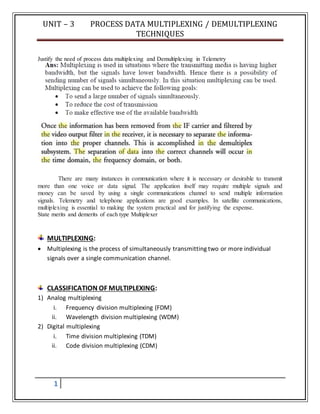
Unit – 3 process data multiplexing demultiplexing techniques
- 1. UNIT – 3 PROCESS DATA MULTIPLEXING / DEMULTIPLEXING TECHNIQUES 1 Justify the need of process data multiplexing and Demultiplexing in Telemetry There are many instances in communication where it is necessary or desirable to transmit more than one voice or data signal. The application itself may require multiple signals and money can be saved by using a single communications channel to send multiple information signals. Telemetry and telephone applications are good examples. In satellite communications, multiplexing is essential to making the system practical and for justifying the expense. State merits and demerits of each type Multiplexer MULTIPLEXING: Multiplexing is the process of simultaneously transmitting two or more individual signals over a single communication channel. CLASSIFICATION OF MULTIPLEXING: 1) Analog multiplexing i. Frequency division multiplexing (FDM) ii. Wavelength division multiplexing (WDM) 2) Digital multiplexing i. Time division multiplexing (TDM) ii. Code division multiplexing (CDM)
- 2. UNIT – 3 PROCESS DATA MULTIPLEXING / DEMULTIPLEXING TECHNIQUES 2 FREQUENCY DIVISION MULTIPLEXING (FDM): In FDM, many signals are transmitted simultaneously with each signal occupying a different frequency slot within a common bandwidth. Each signal modulates a separate carrier. The modulator outputs are added together in a linear mixer or adder. Different signals are thus added together in the time domain but they have a separate identity in the frequency domain. The composite signal at the output of the mixer is transmitted over the single communication channel. The composite signal is applied to a group of band pass filters (BPFs). Each filter will pass only its channel and reject all the other channels. The channel demodulator then removes the carrier and recovers the original signal back. Advantages: A large number of signals can be transmitted simultaneously. It does not need synchronization between its transmitter and receiver. Demodulation of FDM is easy. Disadvantages: Requires large bandwidth. Intermodulation distortion takes place. Suffers from the problem of crosstalk. Large number of modulators and filters are required.
- 3. UNIT – 3 PROCESS DATA MULTIPLEXING / DEMULTIPLEXING TECHNIQUES 3 Applications: Telephone system AM and FM broadcasting TV broadcasting TIME DIVISION MULTIPLEXING (TDM): In TDM, all the signals are not transmitted simultaneously. Instead, they are transmitted one by one. Thus, each signal will be transmitted for a very short time. The TDM system is shown in fig. Here, a single pole rotating switch or commutator is a multiplexer. It rotates at fs rotations per second. The switch arm will rotate and connect N (1, 2. 3, _ _ _, N) input signals one by one and transmit it over communication channel. At the receiver, there is one more rotating switch or commutator used for demultiplexing. It is important to synchronize the speed of commutator 1 and 2. Advantages: Intermodulation distortion is absent. TDM circuitry is not very complex. The problem of crosstalk is less. Disadvantage: Synchronization is necessary for proper operation.
- 4. UNIT – 3 PROCESS DATA MULTIPLEXING / DEMULTIPLEXING TECHNIQUES 4 Applications: Digital telephony Satellite communication Optical fiber communication CODE DIVISION MULTIPLEXING (CDM): When a large number of PCM signals are transmitted over a communication channel, multiplexing of these PCM signals is required. The voice signals are selected one by one and connected to a PCM transmitter by the communication switch SW1. Each sampled signal is then applied to the PCM transmitter and is transmitted over a coaxial cable. The CDM signal is regenerated by an amplifier called repeaters. They remove noise added by the channel. At the destination, the signal is demultiplexed using a PCM receiver. PCM receiver output is connected to different low pass filters via commutator switch SW2. Synchronization between the transmitter and receiver is necessary for proper communication. Advantage: Intermodulation distortion is absent. Disadvantages: Synchronization is necessary for proper operation.
- 5. UNIT – 3 PROCESS DATA MULTIPLEXING / DEMULTIPLEXING TECHNIQUES 5 Application: Digital telephony WAVELENGTH DIVISION MULTIPLEXING (WDM): The WDM system is shown in fig. Here, a number of light sources are used. Each light source emits the light of different wavelength. Optical multiplexer is used on the input side to multiplex these signals. This multiplexed signal is transmitted by optical fiber. A demultiplexer is used on the output side to separate these signal. Detectors are used to detect these signals. Advantages: A single fiber-optic cable can handle dozens of channels, instead of using 12 cables, you only use 1. Disadvantage: Complex transmitters and receivers.They must be wide-band, which means they are more expensive and possibly less reliable Application:
- 6. UNIT – 3 PROCESS DATA MULTIPLEXING / DEMULTIPLEXING TECHNIQUES 6 Fiber optic communication. DEMULTIPLEXING: Demultiplexing is the process of separating two or more individual signals that have been multiplexed. Demultiplexing is exactly the opposite process of multiplexing. This job is done at receiving end.